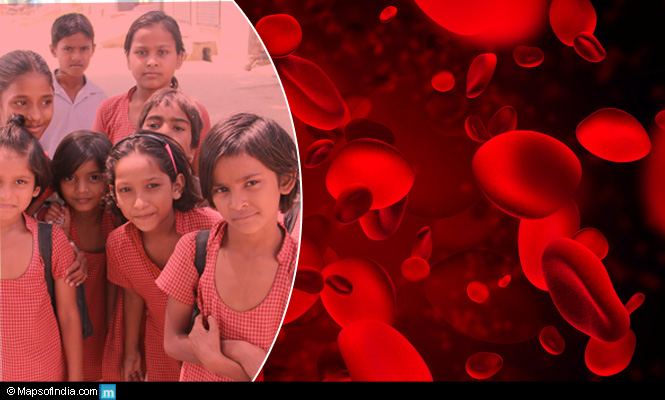 We were conducting a health check-up camp for the children of a primary school in a deprived area. Among various ailments that the children presented with, the overwhelming presence was that of a silent condition which is hardly detected in children: anaemia. Clinically screened for by looking at the inner part of the lower eyelid, almost every child examined had pale conjunctiva – a sign that is called pallor, which is a simple indicator of anaemia.
We were conducting a health check-up camp for the children of a primary school in a deprived area. Among various ailments that the children presented with, the overwhelming presence was that of a silent condition which is hardly detected in children: anaemia. Clinically screened for by looking at the inner part of the lower eyelid, almost every child examined had pale conjunctiva – a sign that is called pallor, which is a simple indicator of anaemia.
Although a disease pertaining to deprivation and malnutrition, anaemia is prevalent among the urban population as well. Children under the age of five, pregnant women, menstruating women and the elderly are particularly at risk. According to the National Family Health Survey, in 2005 and 2006 the following anaemia prevalence rates were recorded in India:
| Anaemia among Children and Adults (NHFS-3 data) | |||
| Population group | Overall | Urban | Rural |
| Children aged 6-35 months (%) | 78.9 | 72.2 | 80.9 |
| Married women aged 15-49 years (%) | 56.2 | 51.5 | 58.2 |
| Pregnant women aged 15-49 years (%) | 57.9 | 54.6 | 59.0 |
| Married men aged 15-49 years (%) | 24.3 | 17.2 | 27.7 |
With Government and NGOs pitching in to improve the nutritional status of the anaemia-prone population groups, it remains to be seen if there is an improvement in these figures when the survey is repeated in 2014-15. According to the UNICEF, iron supplementation is recommended as a means to treat and prevent anaemia in a variety of ways. Some of these include subsidized iron tablets for pregnant women and for those in the reproductive age group, fortification of food items such as grains and flour with vitamins and iron, supplementation of diet of children attending Government schools and Anganwadi centres, increasing the awareness among the target population, etc.
Anaemia, for the record, is caused due to various factors. Iron deficiency is the commonest cause, although deficiency of vitamins such as B12 and folic acid are also very common causes. Other causes include overall nutritional deficiency, blood loss, worm infestations – especially hookworm, destruction of red cells due to various reasons, certain hereditary conditions such as thalassemia and sickle-cell anaemia, among others. If you feel fatigued, easily tire after any activity, feel your heart beat racing away, feel dizzy, or find it difficult to sleep, chances are that you are anaemic. Pregnant women are especially vulnerable to these symptoms, and in severe cases, fetal loss and death.
Iron deficiency anaemia is diagnosed by looking at various parameters; the most important being a low haemoglobin level (normal level is 14-17 g/dl for men and 12-16 g/dl for women), red blood cell number and/or volume. The treatment of iron deficiency is by taking oral iron tablets for a period of at least six months to replenish the depleted iron stores in the body. In severe cases, iron injections may be necessary, and in extreme cases, blood transfusion.
What are the dietary sources of iron? Basically, iron exists in two forms in food stuffs – heme iron, which is present in non-vegetarian foods such as beef, chicken liver, oysters and fish; and, non-heme iron which is present in vegetarian foods such as lentils, beans, nuts, tofu, apricots and spinach. Even though heme iron is absorbed better from the intestines, adding vitamin C (present in citrus fruits) to the vegetarian iron supplement usually aids iron absorption. Conveniently, most of the food stuffs rich in iron are also good sources of vitamin B12 and folic acid, with dairy products like milk and yoghurt also providing additional vitamin B12.
How do I know I am suffering from anaemia?
How can one know if he or she is anaemic? A simple blood test looking at the complete blood count should be enough, and can be easily arranged by a visit to the local lab. If in doubt, it is always better to contact your physician who would be able to arrange for further tests, depending on the type of anaemia that you might have. For children, it is always better to meet the pediatrician before embarking on anaemia assessment or treatment.
Anaemia is an indicator of poor nutrition, deprivation, and the overall health status of the nation. In a country such as India, which is looking to scale greater socio-economic heights, we should be sparing no efforts to monitor, cure and prevent all cases of anaemia.
References:
- http://www.ijcm.org.in/article.asp?issn=0970-0218;year=2011;volume=36;issue=1;spage=8;epage=16;aulast=Kotecha
- http://www.rchiips.org/nfhs/factsheet.shtml
- http://www.unicef.org/india/10._National_Iron_Plus_Initiative_Guidelines_for_Control_of_IDA.pdf
- http://www.webmd.com/diet/iron-rich-foods




